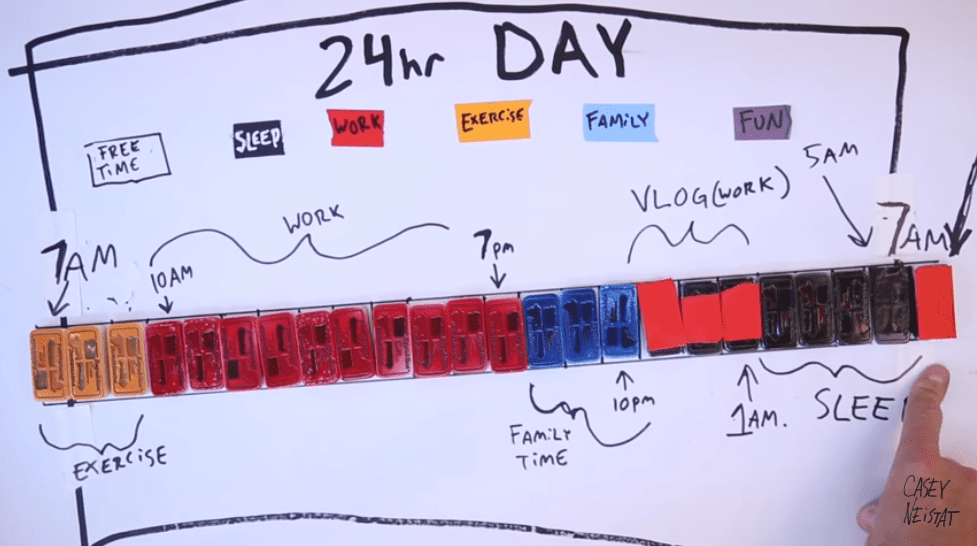|
Getting your Trinity Audio player ready...
|
In 2016, on his one-year anniversary of launching a daily YouTube vlog, Casey Neistat uploaded a video titled “1 trick to 2.5 MILLION SUBSCRIBERS.” The video is nearly 11 minutes long, but his advice for obtaining such a massive following can be summed up in this one segment:
“Before I started vlogging I had a YouTube channel for five years. And in those five years I had a whole bunch of videos that were viral hits. Movies that got 15, 16 million views. But my subscriber growth was anemic. My channel growth was anemic. Five years. 500,000 subscribers. Then I started uploading daily. And in five months I had 500,000 more subscribers. That’s 1 million subscribers. Five years for the first 500,000. Five months for the second 500,000. So I kept uploading. Two months later, I had another 500,000 subscribers. Now here I am, one year after doing daily uploads, and I have 2.5 million subscribers. YouTube isn’t Hollywood. I’m not Stanley Kubrick. You can’t succeed here if you’re uploading once a month. If you want to succeed here, you have to show up here every single day.”
Sounds easy enough. Just post a new video every day. But if you watch a video titled “Fat and Lazy,” which Neistat uploaded about a year earlier, you’ll come to understand how much work goes into actually posting a new video every day. In it, the vlogger uses colored dominoes to graph out his average workday. We learn that he spends his first three waking hours on exercise, goes to work between 10 a.m. to 7 p.m., and then spends three hours with his family. Then it’s back to work; he devotes his remaining waking hours, between 10 p.m. and 1 a.m., to editing that day’s vlog. That leaves a measly four hours for sleep.

Neistat’s work schedule isn’t an anomaly in the world of video creators. Here’s the Twitch streamer Ninja, the first user on the platform to reach 10 million followers, recounting his average workday:
“The schedule is: 9:30 is when I start in the morning and then I play until 4, so that’s like six, six-and-a-half hours,” Blevins said. “Then I’ll take a nice three- to four-hour break with the wife, the dogs or family — we have like family nights, too — and then come back on around 7 o’clock central until like 2, 3 in the morning. The minimum is 12 hours a day, and then I’ll sleep for less than six or seven hours.”
That kind of schedule, over time, takes a toll. Not a week goes by without a famous creator posting a video with a title that’s some variation of “taking a break.” The pressure of generating daily content; managing all other aspects of their career, including corresponding with fans and sponsors; and trying to keep up their non-work commitments with friends and family, often pushes these creators to a breaking point.
Earlier this month, The Guardian wrote about the mental health implications for this kind of stressful lifestyle. As a testament to the willingness of vloggers to open up to their fans, some have posted videos addressing their depression and anxiety. The vlogger Elle Mills published a video earlier this year titled “Burnt out at 19.” A caption at the beginning warns viewers that “the following video includes depictions of mental illness.” At one point, the video shows a tearful Mills screaming at the camera. “This is all I ever wanted. Then why the fuck am I so fucking unhappy? It doesn’t make any fucking sense.”
It seems this is a problem that’s systemic to the video creator community, particularly for solo creators. Why?
There are three main reasons:
The internet has always rewarded consistency
There’s been this persistent assumption that high quality content will always find an audience. This couldn’t be further from the truth. While having quality content certainly helps, consistency of publication has always played a larger role. The more pieces of content you publish, the higher your chances that an article or video will achieve viral liftoff, and it’s incredibly difficult to predict which piece of content that will be.
This truth extends back to the earlier days of the internet. During the mid-aughts, studies found that the most popular blogs, those listed at the top of the Technorati Top 100, posted, on average, 20 times per day. A reader or viewer needs to land on your content multiple times before they begin to recognize you as a creator and decide to subscribe to your channels. Posting only once a week means you’re not providing enough opportunities for users to discover your videos.
Top YouTubers and Twitch streamers have certainly realized this. That’s why they feel constant pressure to post, lest they lose whatever momentum they’ve gained.
Venture-funded media companies are pivoting to video
Surely by now you’ve heard of the infamous “pivot to video” that’s gripping the media industry. Digital publishers, many of them backed by VC money, are now pouring hundreds of millions of dollars into video production. Early YouTubers had very little competition; today, they’re at constant risk of being drowned out by a glut of content produced by professional filmmakers. Imagine being a solo creator and competing with BuzzFeed and its staff of hundreds.
Not only has this forced solo creators to increase their content output, it also puts pressure on them to improve their production quality. Gone are the days of point-and-shoot cameras and grainy video. Most famous vloggers today own an army of drones and thousands of dollars in camera equipment. This has added hours of post-production work for every single video uploaded to the site.
YouTube’s algorithm is now rewarding longer videos
YouTubers aren’t just under pressure to produce more content with higher production quality. Those videos also need to be longer. YouTubers who once were required to make one video per day that lasted between five and 10 minutes are now feeling pressured to double their video lengths to between 10 and 15 minutes.
Why? Two reasons. The first is because YouTube recently tweaked its algorithm so that it now rewards longer videos. This impacts whether your video makes it into the sidebar recommendations list, which is one of the largest driver of views.
The second reason? The adpocalypse. That’s the neologism used to describe YouTube’s reaction when it got caught last year showing ads next to extremist content. Suddenly, its algorithm began flagging many more videos for demonetization, and famous YouTubers saw their ad revenue crater overnight. The solution? Longer videos that contained multiple midroll ads. If you could cram more midroll ads into your video, you could squeeze out more revenue to make up for the money lost for any videos that got demonetized.
***
The pressure to create more and more content is only going to get worse, not better. As long as the video space continues to get more crowded, the more difficult it will be for content to break through the noise.
Which means there won’t be any easy solutions to the mental health issues that plague the YouTube and Twitch communities. Aspiring vloggers will either need to keep up their production schedule or radically adjust their expectations for success.
There may come a point when the venture capital bubble pops, leading to a drastic reduction in the amount of video content being produced, but until then, the competitiveness will remain cutthroat. Many of us would love to become YouTube stars. This harsh, competitive climate is the reason most of us won’t.
***
Key takeaways for publishers:
- YouTube is rewarding longer videos in its algorithm. The age of “keep your videos around five minutes” is over. Many publishers are posting videos that stretch out to 15 minutes long.
- Are you providing your video staff with enough support? Are you setting realistic expectations for what kind of output that’s required of them?
- Longer videos are a way to squeeze more revenue out of your videos, because you can have multiple midroll ad breaks in each video.
Simon Owens is a tech and media journalist living in Washington, DC. Follow him on Twitter, Facebook, or LinkedIn. Email him at simonowens@gmail.com. For a full bio, go here.


